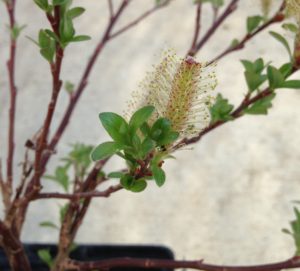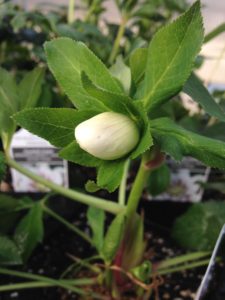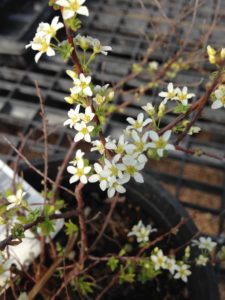The landscape may still be dominated by the browns and tans of winter, but inside the greenhouse is a different story -oodles of green buds bursting out of dormancy, waking up to warm, humid air! It’s refreshing to spend time around these green little beauties, and it is an indicator that plants outside will soon be doing the very same thing.
Buds excite us for many reasons. They portend flowers and color, and the lush greenness to come. But they also are a signal of life! Life after the cold winter months, life after dormancy – a breaking forth from a long sleep, part of the natural cycles of activity and inactivity that we all experience.
Beyond metaphor, their botany is just plain cool! Here are a few things to know about the buds emerging on your landscape plants at home.

Salix Mt. Asama is an early bloomer. It’s bright yellow and pink pollen clusters are showy, suspended on fuzzy, whimsical silks.
What is a Bud?
A pal? A friend? I certainly see them that way! But scientifically speaking, a bud is an embryonic shoot just above where the leaf will form, or at the tip of a stem. As I previously covered in my November post on pruning, there are lots of different types of buds: terminal buds (at top of stem), lateral buds (on sides of stem, producing leaves or flowers), dormant buds (asleep and waiting for spring), and many more.

Buds can be classified by looks or location.
By Mariana Ruiz Villarreal LadyofHats [Public domain], via Wikimedia Commons

‘Confetti Cake’ hellebore has a pure white flowerbud, but when it opens will be spotted with dark purple.
Bud Beasties
Inspecting your buds is important to stopping a potential problem. The first thing to inspect for is aphids. Buds are succulent little treats for these pests, and have less waxy protective coating than mature leaves, making them an easy target. Often the buds won’t show much damage until you have a nasty infestation, so inspecting buds early is key. Be sure to look on the inner folds of the bud if possible, as aphids are quite good at hiding themselves.

Ogon spirea blooms earlier than other spirea, long before it has fully leafed out. The flowers are white with yellow centers and closely clustered together, making a nice effect in the spring landscape.
Health Check
Even if you see buds on your trees, shrubs and outdoor plants, that may not be an indication that everything is A-OK. All too often I see lots of buds on my potted shrubs only to find out that they are dead – by pressing gently on them, they easily break off and reveal dead wood at the wound. If you have any doubt about the hardiness of a shrub or perhaps neglected your winter watering schedule, take a close look at the buds. Buds that are soft and mushy or dry and brittle are a bad sign, and may indicate dead wood that needs trimming back this year. Firm buds that don’t break off at a light touch, be they green or still brown, usually mean they are alive and waiting to spring open.
I’m dismayed that FloraKansas Plant Festival is still months away – so many early blooming plants are at their best right now, budding out and coming alive! Come visit the Arboretum and enjoy all the buds (and bulbs!) that are waking up!
